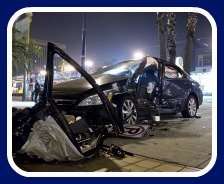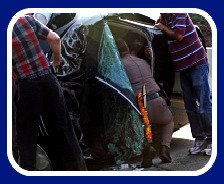Your Headline
Emergencies are always unexpected.
It makes sense to have a Vehicle First Aid Kit on hand in case you are involved in or come across an accident.
Car accident injuries range from... minor injuries, such as bruises,
cuts and scrapes,
to moderate injuries, such as
broken bones.
Then there are the more serious, life-altering injuries, or even fatal injury.
 |
 |
We
have put together a Vehicle First Aid Kit Checklist. Use it as a
starting point and adapt it to your specific circumstance, needs of
passengers, locations you travel to and through as well as weather
conditions.
Our suggestions for a Vehicle First Aid Kit Checklist:-
- A good First Aid Book - including basic CPR instruction.
Over the counter items:
- Antibiotic ointment or powder.
- Antihistamine - for mild allergic reactions.
- Antiseptic gel (the no need for water type) - for cleaning your hands before touching open wounds.
- Antiseptic wipes - for wiping over small wounds, cuts and scrapes.
- Aspirin or other pain relievers - what you would normally take for pain.
- Burn gel with Aloe Vera - Aloe Vera aids in healing, pain relief has anti-inflammatory properties helps prevent blistering and scarring.
- Stings and bites cream - I prefer one with a local anaesthetic especially for the kids.
- Hydro-cortisone cream - for skin inflammation and rashes.
Other contents to add to a good Vehicle First Aid Kit are:-
- CPR Mask - learn how to perform CPR before you need it for real.
- Elastic and crepe bandages - a few different widths.
- Gauze and non-stick dressing pads - preferably sterile.
- Gauze squares - for either applying cream, gels or antiseptic or for putting pressure on and absorbing blood from bleeding wounds. We prefer not to use cotton balls as the fibres can get left behind in the wound and may cause trouble later. But if that is all you have go ahead and use them as they are better then nothing.
- Triangular bandage - For slings, padding, strapping fractured limbs to splints if a fracture is suspected.
- Adhesive tape.
- Band aids - a variety of shapes and sizes for small
cuts and scrapes.
- Instant cold packs - The kind you snap to make it cold. These are so useful with bruising, swelling and sprains. They are single use, so if you have space grab a couple for your kit.
- Two tongue depressors or ice block sticks for finger splints.
- Normal saline 10ml vials for the double use as an eye wash or wound cleansing.
- Synthetic gloves: Put in a few pairs of these.
- Moist towelettes/wipes - for those times when you need to clean dirt or mud etc off someone or something.
- Saline solution - for flushing wounds and eyes.
- Sunscreen/Insect repellent - to prevent sunburn and insect bites when that picnic or football game goes just that bit longer.
- If going on a long trip take a thermometer.
- Torch - the shake or wind up type so you do not need batteries.
- Tweezers - good quality ones. The cheap quality ones often do not do the job and are therefore frustrating.
- Curved Scissors - Scissors come in handy and have many uses. Curved medical ones are great as they don't have sharp points. In an emergency you might need to cut clothes away from an injury site and it is easy to poke through something and cause further injury when you are in a hurry or under stress.
- Mobile phone - most people have one these days but worth mentioning.
If you have children you may need to pack:
- Any prescription medication that your child might be taking including asthma inhalers, epi-pen or allergy medication.
- Children's pain reliever liquid if they have trouble swallowing tablets.
- Children's-strength liquid decongestant - again if they do not swallow tablets yet.
Storage container:
- A tackle box or art-supply box works well for storing Vehicle First Aid Kit supplies. They are lightweight, strong for when it gets knocked about, have handles for easy carrying, and generally have trays or swing out sections for storing small items to keep them in order.
- Using clip lock bags to store certain items in to categories is a great idea so things can be found in a hurry.
Other things to consider when putting together a Vehicle First Aid Kit:
If going on a long trip remember to pack in your bags any prescription medication you or other passengers are taking. Whether it be for asthma, allergies or some other aliment because a pharmacy/drug store may be quite a distance away.
When an accident or injury occurs you may not have much time to read a manual while trying to give first aid to an injured person. We at FirstAidAnywhere.com recommend you do a First Aid Training Course to learn what first aid challenges you may encounter and how to treat them.
The course you choose should include performing CPR, how to stop bleeding, First Aid for Cuts and Scrapes, how to stabilise a fractured limb, and how to treat burns, insect bites and other injuries.
Whether you are planning a long distance drive, day trips or just
use the car for carpools and shopping, having a vehicle first aid kit
can help you and others feel safer and prepared for those unexpected
emergencies.
Now you have read about what to put in a good vehicle first aid kit you may be interested in the following:
Basic First Aid Instructions
First Aid for Bee Stings
First Aid for Minor Burns
First Aid for Nosebleeds
1st Photo courtesy of
Steve Lyon
2nd Photo courtesy of
Craig O'Neal
both photos under Creative Commons License Deed
Attribution-Share Alike 2.0 Generic